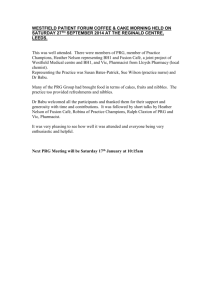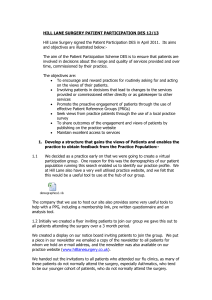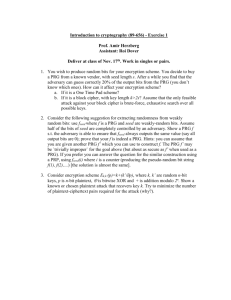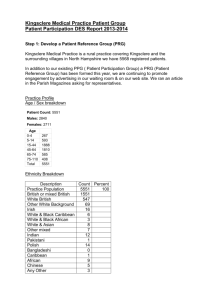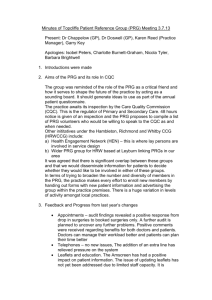Patient Participation Directed Enhanced Service
advertisement
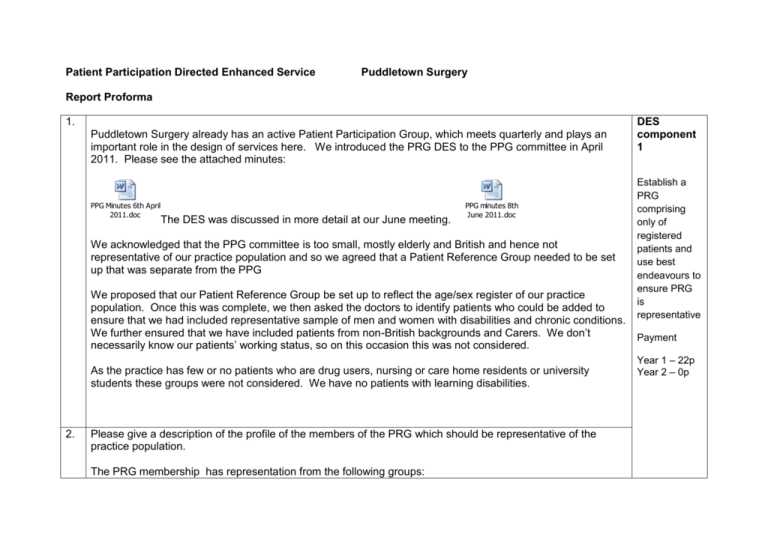
Patient Participation Directed Enhanced Service Puddletown Surgery Report Proforma 1. Puddletown Surgery already has an active Patient Participation Group, which meets quarterly and plays an important role in the design of services here. We introduced the PRG DES to the PPG committee in April 2011. Please see the attached minutes: PPG Minutes 6th April 2011.doc The DES was discussed in more detail at our June meeting. PPG minutes 8th June 2011.doc We acknowledged that the PPG committee is too small, mostly elderly and British and hence not representative of our practice population and so we agreed that a Patient Reference Group needed to be set up that was separate from the PPG We proposed that our Patient Reference Group be set up to reflect the age/sex register of our practice population. Once this was complete, we then asked the doctors to identify patients who could be added to ensure that we had included representative sample of men and women with disabilities and chronic conditions. We further ensured that we have included patients from non-British backgrounds and Carers. We don’t necessarily know our patients’ working status, so on this occasion this was not considered. As the practice has few or no patients who are drug users, nursing or care home residents or university students these groups were not considered. We have no patients with learning disabilities. 2. Please give a description of the profile of the members of the PRG which should be representative of the practice population. The PRG membership has representation from the following groups: DES component 1 Establish a PRG comprising only of registered patients and use best endeavours to ensure PRG is representative Payment Year 1 – 22p Year 2 – 0p Patients who work Patients who don’t work Patients who are retired Patients from Polish community Carers Patients with chronic disease Patients with disability It was not possible to get representation from the following groups: Drug users University students 3. Please outline the steps taken to ensure that the PRG is representative of the practice registered patients. The practice age/sex register was used as a basis for establishing the numbers of patients included in each age range. We then added representatives of Carers, Patients from the Polish community, patients with a chronic condition and patients with a disability. Having thus identified our PRG, we e-mailed to this group. Please see that attached message. DES component 1 Establish a PRG comprising only of registered patients and use best endeavours to ensure PRG is representative Payment Year 1 – 22p Year 2 – 0p E-mail message to Icontacts.rtf 4. Where a category of patients is not represented, please outline the steps taken to attempt to engage with that group(s). Work is being undertaken with LINks/ voluntary organisations to engage with the vulnerable groups in the area so that we have an improved PRG for next year. We also noted that no questionnaire responses were received from those under 24, so we propose to consider DES Facebook, Twitter and other means to access the view of this section of our population. component 1 Establish a PRG comprising only of registered patients and use best endeavours to ensure PRG is representative Payment Year 1 – 22p Year 2 – 0p 5. Please give details of the steps taken to determine and reach agreement on the issues which had priority and were subsequently included in the local practice survey. The PPG committee and staff were asked what they considered to be the priority areas we needed to address in the practice. Please see the attached questionnaire (with the fully logged responses) and minutes of the meetings where these were discussed. Consultation questionnaire.xls PPG minutes 8th June 2011.doc DES component 2 Agree with the PRG which issues are a priority and include these in a local practice survey Payment: Year 1 – 22p Year 2 – 11p 6. Having agreed the priorities with the PRG, the questions were drawn up by a sub committee of 5 members of the Patient Participation Group. These were then presented to the PPG committee and to the Full practice staff team. Please see minutes attached. PPG Minutes 14th September 2011.doc 8-3rd August 2011.rtf Once the survey was agreed (See attached) it was sent out to the PRG using the survey facility on our IContacts software. Puddletown Surgery Patient Survey Autumn 2011.dot 7. The practice recognised that it would be really useful, not only for this DES, but for other matters on which the we might wish to harvest the opinions of a representative sample of patients, to have a group who could be readily contacted by e-mail. As we have for a number of years, been collecting our patients’ e-mail contact addresses, we had a goodly number of patients who could be contacted in this way. It was for these reasons that we decided to send out the questionnaire by e-mail. Additionally the software we chose to use also provided a useful report upon receipt of the completed questionnaires. DES component 3 Collate patient views through local practice survey and inform PRG of the findings Payment: Year 1 – 22p Year 2 – 22p DES component 3 Collate patient views through local practice survey and inform PRG of the findings Payment: Year 1 – 22p Year 2 – 22p 8. The PPG Committee met to discuss the findings. The full practice team also met to discuss the findings. Minutes of both these meetings were taken and the action plan developed. DES component 4 The minutes of the PPG meeting containing the action plan are here: Provide PRG with opportunity to comment and discuss findings of local practice survey practice survey. Reach agreement with PRG of changes in provision and manner of delivery of services. Where the PRG does not agree significant changes, PPG Minutes 7th December 2011.doc agree these with the PCT Payment: Year 1 – 22p Year 2 – 33p 9. Please see below details of the action plan: Improve contact with patients under 25 years of age. Consider Facebook, Twitter and local sports and youth groups. Also contact LINKs to see if they could help us to find other organisations locally where young people can be consulted over health matters Improve internal communication between GPs and Dispensers Examine information provided by the practice to see if we can find out how where the information provided by is not be as good as it could be and change it. Adopt a dress code and ensure that any refreshments are enjoyed out of sight of the public Consider installing an island unit in the dispensary so that dispensers don’t have their backs to the patient serving hatch. DES component 5 Agree with the PRG an action plan setting out the priorities and proposals arising out of the local practice survey. Seek PRG agreement to implement changes and where necessary inform the PCT. Payment: Year 1 – 22p Year 2 – 33p 10. 200 Questionnaires were sent out and 63 were returned. Here is the report compiled from the completed questionnaires. 11. Please give details of the actions which the practice intend to take as a consequence of discussions with the PRG in respect of the results, findings and proposals arising out of the local practice survey. Improve contact with patients under 25 years of age. Consider Facebook, Twitter and local sports and youth groups. Also contact LINKs to see if they could help us to find other organisations locally where young people can be consulted over health matters Improve internal communication between GPs and Dispensers Examine information provided by the practice to see if we can find out how where the information provided by is not be as good as it could be and change it. Adopt a dress code for frontline staff and ensure that any refreshments are enjoyed out of sight of the public Consider installing an island unit in the dispensary so that dispensers don’t have their backs to the patient serving hatch. Conduct a review of public transport to Puddletown from villages in our practice area and check the fit DES component 5 Agree with the PRG an action plan setting out the priorities and proposals arising out of the local practice survey. Seek PRG agreement to implement changes and where necessary inform the PCT. Payment: Year 1 – 22p Year 2 – 33p with the timings of our surgery clinics. 12. Where any changes will have contractual implications have these been discussed with the PCT? If not please describe your proposals for discussion. None of these changes have contractual implications 13. Please detail the opening hours of the practice premises and how patients can access services throughout the core hours. The practice is open 8.30 – 6.30 Monday to Friday and 8.30 – 11.00 on Saturday. Patients can access GPs in morning (open) and evening (appointment) clinics. The doctors are also available by telephone 8.30 – 9.00 and 3.30 – 4.00 daily. They also receive e-consultations sent in via our website. Patients can access Nurses, Counsellors, Physiotherapist, Chiropodist, Health Visitors by appointment at clinics during the core opening hours. Patients wishing to receive a visit may telephone to request one. The Practice has an on-line appointment system for those who wish to use it. 14. If the practice offers extended hours, please give the times at which individual healthcare professionals are accessible to registered patients. The doctors provide an open morning surgery (no appointment needed) every Saturday between 8.30 and 10.00am. 15. Publicise the Local Patient Participation Report on the practice website The Patient Survey is (has been since December 2011) on our website at www.puddletownsurgery.co.uk. DES component 6 Publicise the Local Patient Participation Report on the practice website and update the report on subsequent achievement Payment: Year 1 – 0p Year 2 – 11p
